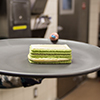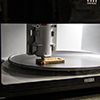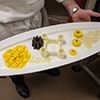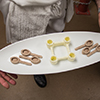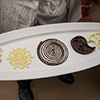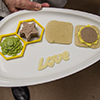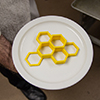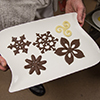You’re accessing archived content
This is archived content from the UIT website. Information may be outdated, and links may no longer function. Please contact stratcomm@it.utah.edu if you have any questions about archived content.
University Hospital now printing – yes, printing – real food
Imagine your favorite food: maybe it’s pizza, or mac and cheese. Now, imagine eating it after it’s been thrown in a blender.
For patients with dysphagia, a condition that requires a consistency-modified diet, this is a common reality. But even the blended food is an improvement – years ago, dysphagia patients were simply served baby food.
Things improved a bit when manufacturers began creating pureed foods in shapes (the peas look like peas, the carrots look like carrots, and so on).
“That has improved a lot, but the challenge with that is that it is just not really flavorful,” said Laura Robson, Director of Nutrition Care Services at the University Hospital. In general, dysphagia patients don’t need bland diets – they’re able to eat seasoning and spices – and so this version of pureed, shaped food simply didn’t taste very appetizing.
Enter 3D food printing. About a year ago, Robson saw a 3D food printer in a trade journal and was immediately intrigued. Fast forward to now, and the newly-arrived Foodini was installed and hooked up to the network on April 7, thanks to UIT’s very own Curtis Larsen, Ray Carsey, and Christian Johnson.
“It is really exciting,” said Robson. “Even though we don’t have a lot of patients on those diets in the grand scheme of things, they are often times on them for quite a while.”
Since it arrived, the nutrition department and hospital chefs have been busy creating and blending food that can easily pass through the stainless steel cylinders in the printer.
“We are making everything [in-house]. We’re cooking things, then pureeing them,” said Robson. She said they also have plans to naturally add color to some of the printed items, via beet or carrot juice.
After the food has been pureed and printed, it gets flash frozen and sealed in a Sammic Vacuum Sealer, ready to be refreshed in the oven at any time.
“That is the really exciting part,” said Robson. “It can freeze so quickly that it doesn’t break down the structure of the product.”
“You would not know it wasn’t prepared fresh,” she added. “You don’t lose any quality.”
Robson estimates they’re 1-2 months away from serving printed food to the hospital’s dysphagia patients. She’s hopeful that patients’ food intake will improve as they begin serving items that more closely resemble real food.
“If it looks good, you are more inclined to eat more of it,” she said.
From baby food to food that’s been 3D printed, it’s just one more way technology continues to improve our lives.
Node 4
Our monthly newsletter includes news from UIT and other campus/ University of Utah Health IT organizations, features about UIT employees, IT governance news, and various announcements and updates.

